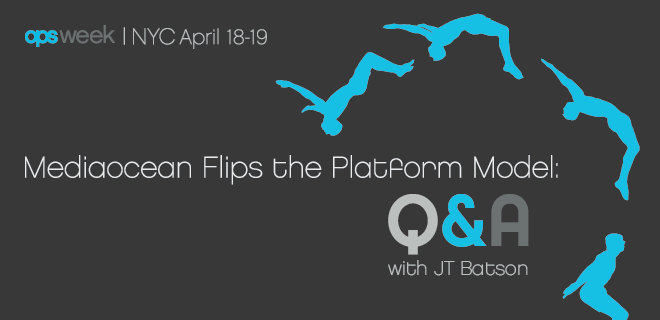
Together at long last – after receiving the OK from the Justice Department in late February, former rivals Donovan Data Systems and MediaBank officially joined forces on March 1 to become Mediaocean. At OPS Markets on April 18 in NYC – and in one of their first public speaking engagements since the merger – former DDS President JT Batson will discuss how to make the media technology stack an efficiency engine for all parties in the advertising ecosystem.
Check out the teaser video:
Of course, their ultimate solution is the Mediaocean OS, one operating system to rule (well, more like manage) them all – that is, the seemingly infinite number of platforms out there across an ever-growing supply of channels. We caught up with JT before the big date to hear why the OS ain’t just another platform, the biggest challenges in linking buy- and sell-side systems and how Mediaocean is preparing for the convergence of TV and digital video (something AdMonsters plans to thoroughly investigate at OPS TV, July 11 in the Big Apple).
What is the difference between a media-buying OS and your everyday platform?

In the current model, your media management platform acts as the sole hub through which you do the bulk of your business, and it integrates with a certain number of third-party providers that help you do your business even better. For third-party technologies and data providers that most agencies use – like a Nielsen, say – everyone has access to the same integration. The media management platform can also be customized to integrate with specific third-party technologies as needed by specific clients.
That’s been a reasonable model in an era of a limited number of technology requirements—when the “universally-needed” third-party applications were fairly predictable, and the customization needs were relatively limited. Mediaocean’s legacy companies, Donovan Data Systems and MediaBank, were built on that model and served the industry well for decades.
But there are two factors that are starting to change that status quo.
The first is that the media landscape is in a continual state of flux. The set of technology that’s relevant today is completely outdated tomorrow (especially in digital media).
The second change is that, the more technology we have available to execute strategies, the more agencies are called upon to leverage those technologies to develop specific solutions and technology stacks for each client. And so – to offer an oversimplified example – a car company that’s primarily interested in generating brand awareness will press heavily on engagement technologies; a computer business that’s primarily a direct marketer might want to focus on call center applications and data management.
The upshot of both of those changes is that third-party integration needs are changing all the time, and there’s a shrinking “standard set” of integrations that universally applies to all advertisers and all agencies. Plus, the need to work across channels and global markets means that agencies are looking for a single point from which to coordinate all that technology across the unique stack. To achieve all that, you need a staggering number of truly deep integrations – and you need to update the integrations all the time. “Staggering” is a very hard number to handle at scale.
All of this is why we realized that we needed to flip the model. Instead of creating a single platform that requires constant readjustment to integrate with every new technology, we’re creating a core infrastructure that’s open enough—with universal API’s—that allows other technologies to easily develop their platform to plug into ours. In other words, we’re creating an “app store” for media technology.
That “app store” is Mediaocean OS. It’s a way for agencies to get the most specific media technology stacks possible, in a way that allows us to continually provide specific, up-to-date solutions for every advertiser.
The issues we’re trying to tackle aren’t just a challenge for agencies, by the way. They’re challenges for publishers, too. First, because there’s a direct correlation between the effectiveness advertisers feel they’re getting from their media spend, and the amount they’re willing to continue to invest in media. Second, because different kinds of media executions require unique integrations not just with third-party technologies, but with publishing technologies as well.
And so Mediaocean OS is something we’re creating to solve problems for ever part of the business – advertisers, agencies, and publishers. It benefits the whole ecosystem.
Technologically speaking, what are the biggest challenges in linking buy- and sell-side operations? What kind of developments do you think we’ll see on that front this year?
The biggest problem is the complexity problem. Some of that complexity comes from point solutions: the bevy of single-solution technologies that agencies and publishers need to get their jobs done, but are also adding inefficiency in the mix and taking “tolls” between agencies and publishers.
Other complexity comes from a lack of formal business and technology standards, that results in too many steps of contact between media buyers and media sellers, especially on prime inventory—from phone calls, to e-mails, to faxes and more, all to manage a single buy. That’s true across the board; but it’s particularly egregious in the newest media—that, for all the efficiencies they provide to consumers, still don’t have the same technology and infrastructure built out to service their advertisers that industries like television have created over the decades.
These are problems that make it really hard for agencies to drive spend to publishers. The answer to both of them is to create systems that ease integration and coordination across different parts of the business – to turn the point solutions into a manageable, coherent system; and to enable direct interaction between media buyers and media sellers. That kind of ease of integration and coordination is exactly what we’re looking to offer through Mediaocean OS.
What other operational challenges does Mediaocean plan to tackle off the bat?
Obviously, we’re 110% committed to servicing our clients – the agencies, publishers and networks who use our systems to manage their operations, procurement and planning. That’s always been our business, and it always will be. The only things that’s changed is that, as technology moves from a back-office to a front-office function, the challenges we’ve always addressed are only becoming more important to the clients we serve. That’s more pressure for us, but it also makes this a really exciting time to be in this business.
Plus, it means we get to say that we were in media plumbing before it was cool.
How is Mediaocean preparing for the convergence of digital video and TV advertising?
The trend to watch here is this: everyone is looking to manage holistically and agnostically across digital and “traditional” realms, including in traditional and digital video. Agencies are looking to empower universal optimization and cross-channel storytelling. Digital video networks want a piece of the network TV pie. Meanwhile, the traditional networks know that moving into the future means controlling the multichannel brand presence—just look at NBC live-streaming this past Super Bowl.
In the short term, we are working on making it easy to buy digital video through the TV buying systems. That will present opportunities for anyone selling digital video to plug in—making buying/selling easier on everyone. More broadly, through the Mediaocean OS, we are making sure agencies and media companies are able to trade however they want going forward. Agencies and their trading partners need to be able to take their own points of view on how they want to transact and how fast they want to start doing it – and we surely can’t let “systems” slow them down.
 |
Catch Mediaocean’s JT Batson team up with CEO Bill Wise for the exhilerating morning keynote at OPS Markets, which will bring digital advertising leaders and ops professionals together to discuss and develop best practices for operational excellence in the evolving automated landscape. Register today for OPS Markets, which will be held April 18, 2012, in New York. |